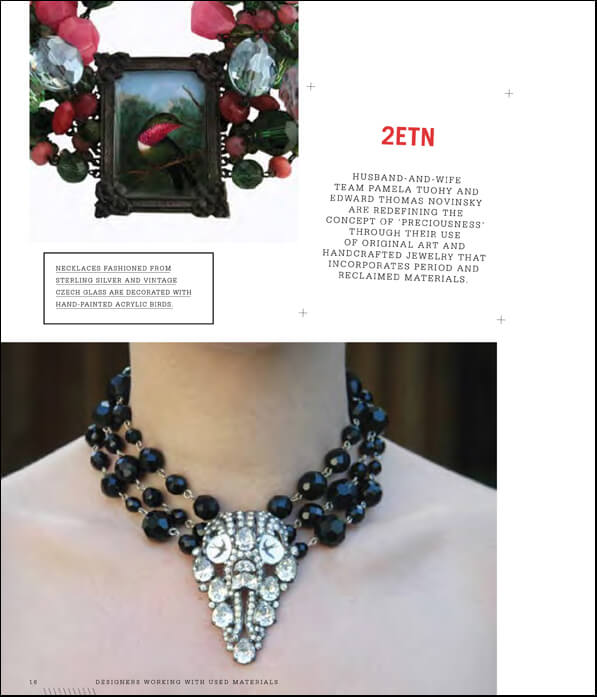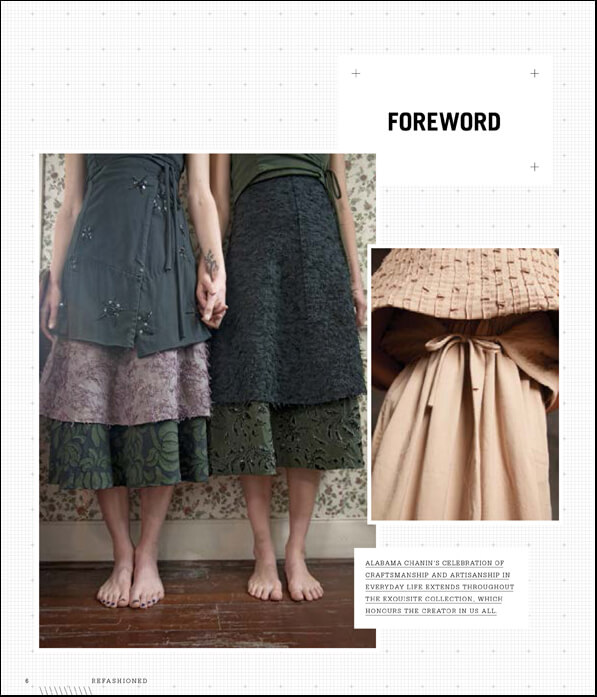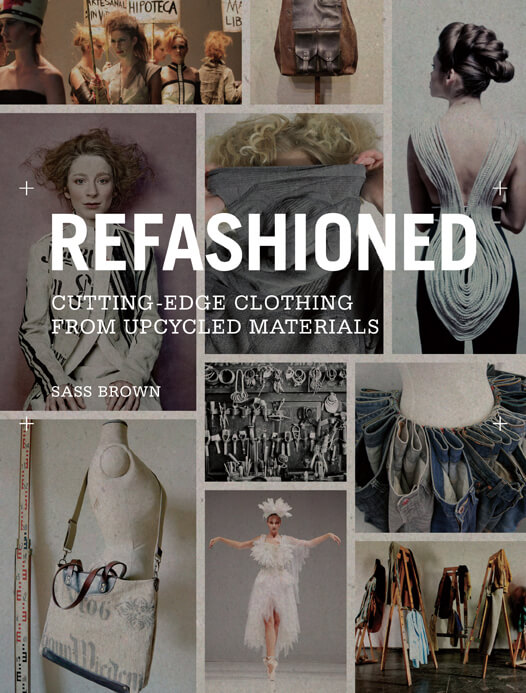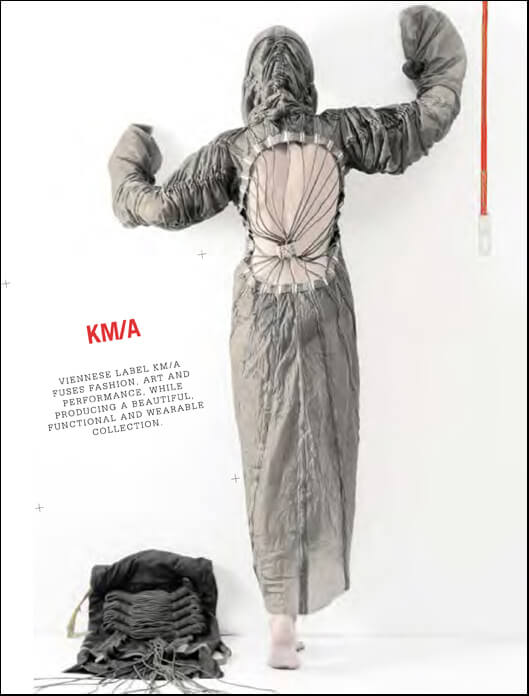Words by Lula Criado
Designer, teacher, writer, lecturer, innovator and global nomad —born in Canada and raised in Montreal, New York, New Orleans, Scotland and London— Sass Brown is the author of two of the most interesting and disruptive books written about ethical fashion: Eco Fashion and Refashioned: cutting-edge clothing from upcycled materials.
Fashion, consciousness, sustainability and social development are the central themes of her work revealing to us how other ways of manufacturing —such as recycling and upcycling— can be balanced with ethical fashion business practice and creativity.
The fashion designers featured manage to be equally avant-garde and sustainable. They blend creativity and business awareness and push the boundaries of the Fashion System to new heights.
There is a massive groundswell of young emerging designers working with new materials, finding new ways of working with old materials, Brown told me. Do you know who made your clothes? The Fashion System is a language. Our clothes tell a story about who we are. However, they would tell a better one if before purchasing them, we all think about who made them.
You are a fashion designer, a writer, a researcher and an educator focused on the topic of eco-fashion, when and how do the fascination with eco-fashion captured your imagination?
Like many things it just all sort of happened, it wasn’t part of a master plan. I have been a designer my entire life, and was always concerned with issues like waste and working with individual creators and crafters. After working in the industry for many years, I became a bit jaded with the commerce of it all and fell into teaching.
That led me to represent FIT at various conferences and events, the very first of which was an international textile conference in Rio, Brazil. Synchronistically I read an article about a Brazilian designer and a women’s cooperative in that area, directly before leaving, and the conference organizers facilitated my communication with both. The cooperative contact grew from a first meeting to me spending up to 4 months a year for 5 years in a row volunteering, visiting, and working with them.
I did my Masters with a focus on sustainability, which diversified my knowledge base from social development to eco-fashion in many of its various different expressions, and resulted in my first book Eco Fashion.
I went on to research, speak, meet and write about sustainable development, designers working with organic and biodynamic fabrications, slow design, and designers working with reclaimed material. I now write for my own website, various commercial magazines, give talks, lectures and advisement to governmental agencies, NGO’s, women’s cooperative, the creative industries and Universities, world wide.
The original allure to eco-fashion was the desire for collaboration, transparency and sharing, all diametrically opposed to the mainstream fashion system I grew tired of.
What is your chief enemy of creativity?
Lack of vision and perceived limitations.
You were born and raised in London, what or who were your influences?
Actually, I was born in Canada, raised in Montreal, New York, New Orleans, a tiny village in Scotland situated between Glasgow and Edinburgh, a small town in the North of England, and London all before I reached age 18.
Hence why I now consider myself a global nomad, having added multiple other cities and countries to that list since then. By default, I am inspired by different locations, traditions and cultures. When I first became interested in design probably my first design hero’s were Zandra Rhodes and Bill Gibbs.
Fashion System is living a period of experimentation with the pioneering applications of technology and the new uses of (old) materials. Are the use of recycled and upcycled materials shaping future conceptions of fashion and clothing? Should we talk about a re-evolution of a re-definition of the Fashion System?
I think the industry, in general, is always affected by new technology and developments. There are certainly interesting things happening in fashion and textiles, but the invention of the cotton gin or the sewing machine were also game-changers in the sphere of fashion and textiles in their time.
I think one of the biggest changes globally is a rejection of pre-determined systems, whether those are the systems of fashion or the systems of banking and corporate structure. More people feel empowered to start their own businesses, make new collaborations and try new things.
There is a massive groundswell of young emerging designers working with new materials, finding new ways of working with old materials, and entirely new business models and fashion systems, and that is truly exciting.
That includes a range of designers rethinking what waste means and finding new ways of utilizing it. I think the entire system of fashion is in the process of being redefined with a focus on the makers, and with respect for all those hands involved in the processing of the materials they use, and the resulting effects on the environment, instead of simply on profit. We are in the process of redefining what success means, and quality of life and that is exciting.
Fashion, like most other disciplines, are implementing more and more eco-friendly measures mainly focused on the final product. However, the tragedy in Bangladesh on April 2013, where 1133 fashion workers were killed, revealed that the fashion business’s practice is not always ethical and sustainable.
Business is not ethical and has not been for some time when the focus of a corporation is purely profit and return on investment, then everything else becomes secondary, and that includes people and planet. The fashion industry has been divesting itself of its direct responsibility for production for decades now, finally, it is beginning to understand that corporations will be held responsible for the treatment of the people and the planet that are affected through their manufacture whether they own those facilities or not.
There is still a very long way to go in this battle, but we owe a lot to the likes of Greenpeace, Labor Behind the Label and the Clean Clothes Campaign’s tireless focus on the fashion and textile industry and highlighting those responsible for the worst of the crimes.
Would you agree that regarding the production phase, the lack of ethics showed by (but not only) fast-fashion retailers has become a pending issue?
I think this is one of the biggest issues of our time, and one that has remained hidden to all but those directly involved until recently. The gross disrespect of people and the planet has still to fully come to the average consumers’ attention. Nevertheless, we are fast running out of resources with which to maintain “business as usual”.
This is true of all industries, from computing to fashion, farming to medicine. We have to find kinder, gentler means of doing business that considers the triple bottom line with equal weight, that of people, planet and profit, and not just profit, or someone or something will always be paying the price.
Is there a strategy by the most important labels to work on that?
There are agreements such as the Bangladesh Safety Accord that are designed to support fair treatment and payment of workers. There are also a number of certifications and certifying bodies that can oversee the various different components of the growing, and production of garments, most of which are voluntary and have costs attached to them.
The development of the HIGGS Index however I think will help unify the understanding of all the various elements involved in the fair and ethical production of our clothing and the measuring of that impact, and hopefully result in a globally recognized ranking system.
You couldn’t live without…
My closest friends, they are my chosen family in this life.
One for the road… (A question that is ever-present in a designer’s mind), what is the future of fashion?
I sincerely hope a fair, ethical and ecological one, that allows us to live in harmony with our planet instead of bleeding it dry, and one that honours the labour of others and pays them a fair wage whether they are the farmers of the fiber or the weavers of the cloth.










